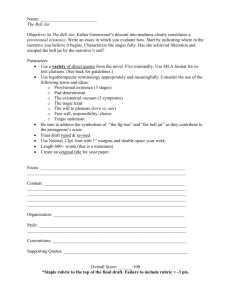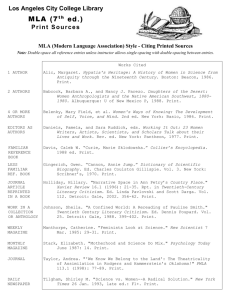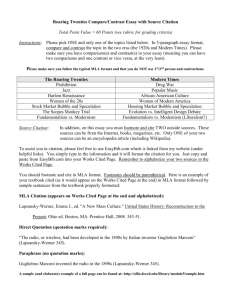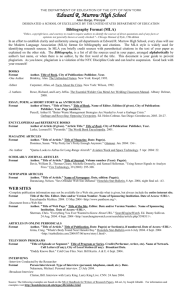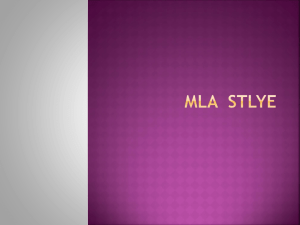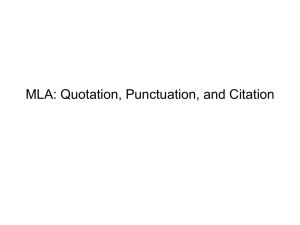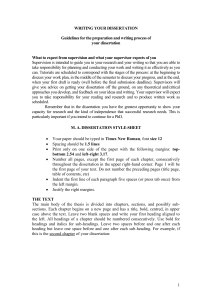MLA Style: Handling Quotations In Your Text
advertisement
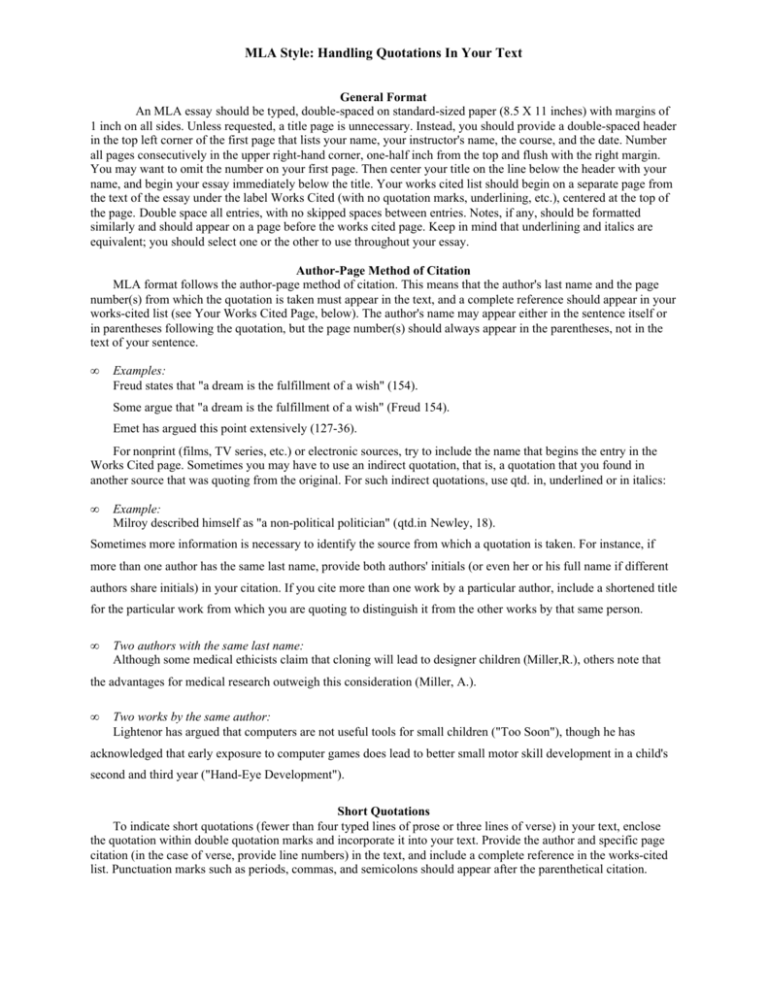
MLA Style: Handling Quotations In Your Text General Format An MLA essay should be typed, double-spaced on standard-sized paper (8.5 X 11 inches) with margins of 1 inch on all sides. Unless requested, a title page is unnecessary. Instead, you should provide a double-spaced header in the top left corner of the first page that lists your name, your instructor's name, the course, and the date. Number all pages consecutively in the upper right-hand corner, one-half inch from the top and flush with the right margin. You may want to omit the number on your first page. Then center your title on the line below the header with your name, and begin your essay immediately below the title. Your works cited list should begin on a separate page from the text of the essay under the label Works Cited (with no quotation marks, underlining, etc.), centered at the top of the page. Double space all entries, with no skipped spaces between entries. Notes, if any, should be formatted similarly and should appear on a page before the works cited page. Keep in mind that underlining and italics are equivalent; you should select one or the other to use throughout your essay. Author-Page Method of Citation MLA format follows the author-page method of citation. This means that the author's last name and the page number(s) from which the quotation is taken must appear in the text, and a complete reference should appear in your works-cited list (see Your Works Cited Page, below). The author's name may appear either in the sentence itself or in parentheses following the quotation, but the page number(s) should always appear in the parentheses, not in the text of your sentence. • Examples: Freud states that "a dream is the fulfillment of a wish" (154). Some argue that "a dream is the fulfillment of a wish" (Freud 154). Emet has argued this point extensively (127-36). For nonprint (films, TV series, etc.) or electronic sources, try to include the name that begins the entry in the Works Cited page. Sometimes you may have to use an indirect quotation, that is, a quotation that you found in another source that was quoting from the original. For such indirect quotations, use qtd. in, underlined or in italics: • Example: Milroy described himself as "a non-political politician" (qtd.in Newley, 18). Sometimes more information is necessary to identify the source from which a quotation is taken. For instance, if more than one author has the same last name, provide both authors' initials (or even her or his full name if different authors share initials) in your citation. If you cite more than one work by a particular author, include a shortened title for the particular work from which you are quoting to distinguish it from the other works by that same person. • Two authors with the same last name: Although some medical ethicists claim that cloning will lead to designer children (Miller,R.), others note that the advantages for medical research outweigh this consideration (Miller, A.). • Two works by the same author: Lightenor has argued that computers are not useful tools for small children ("Too Soon"), though he has acknowledged that early exposure to computer games does lead to better small motor skill development in a child's second and third year ("Hand-Eye Development"). Short Quotations To indicate short quotations (fewer than four typed lines of prose or three lines of verse) in your text, enclose the quotation within double quotation marks and incorporate it into your text. Provide the author and specific page citation (in the case of verse, provide line numbers) in the text, and include a complete reference in the works-cited list. Punctuation marks such as periods, commas, and semicolons should appear after the parenthetical citation. MLA Style: Handling Quotations In Your Text Question marks and exclamation points should appear within the quotation marks if they are a part of the quoted passage but after the parenthetical citation if they are a part of your text. • Examples: According to some, dreams express "profound aspects of personality" (Foulkes 184), though others disagree. According to Foulkes's study, dreams may express "profound aspects of personality" (184). Is it possible that dreams may express "profound aspects of personality?" (Foulkes 184). Cullen concludes, "Of all the things that happened there / That's all I remember" (11-12). Long Quotations Place quotations longer than four typed lines in a free-standing block of typewritten lines, and omit quotation marks. Start the quotation on a new line, indented one inch from the left margin, and maintain double-spacing. Your parenthetical citation should come after the closing punctuation mark. When quoting verse, maintain original line breaks. (You should maintain double-spacing throughout your essay.) • Examples: Ralph and the other boys finally realize the horror of their actions: The tears began to flow and sobs shook him. He gave himself up to them now for the first time on the island; great shuddering spasms of grief that seemed to wrench his whole body. His voice rose under the black smoke before the burning wreckage of the island; and infected by that emotion, the other little boys began to shake and sob too. (Golding 186) Elizabeth Bishop's "In the Waiting Room" is rich in evocative detail: It was winter. It got dark early. The waiting room was full of grown-up people, arctics and overcoats, lamps and magazines. (6-10) A Note on Footnotes and Endnotes Because long explanatory notes can be distracting to readers, most academic style guidelines (including MLA and APA) recommend limited use of footnotes/endnotes. An exception is Chicago-style documentation, which relies on notes for all citations as well as explanatory notes. But even in that case, extensive discursive notes are discouraged. Proper use of notes would include: • Evaluative bibliographic comments, for example: See Blackmur, especially chapters three and four, for an insightful analysis of this trend. On the problems related to repressed memory recovery, see Wollens pp. 120- 35; for a contrasting view, see Pyle. • Occasional explanatory notes or other brief additional information that would seem digressive if included in the main text but might be interesting to readers, for example: In a 1998 interview, she reiterated this point even more strongly: "I am an artist, not a politician!" (Weller 124). Footnotes in MLA format are indicated by consecutive superscript arabic numbers in the text. The notes themselves are listed by consecutive superscript arabic numbers and appear double-spaced in regular paragraph format (a new paragraph for each note) on a separate page under the word Notes (centered, in plain text without quotation marks).

